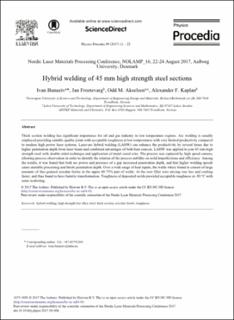| dc.contributor.author | Bunaziv, Ivan | |
| dc.contributor.author | Frostevarg, Jan | |
| dc.contributor.author | Akselsen, Odd Magne | |
| dc.contributor.author | Kaplan, Alexander F.H. | |
| dc.date.accessioned | 2020-12-22T07:27:31Z | |
| dc.date.available | 2020-12-22T07:27:31Z | |
| dc.date.created | 2017-11-06T11:40:10Z | |
| dc.date.issued | 2017 | |
| dc.identifier.citation | Physics Procedia. 2017, 89 11-22. | en_US |
| dc.identifier.issn | 1875-3892 | |
| dc.identifier.uri | https://hdl.handle.net/11250/2720673 | |
| dc.description.abstract | Thick section welding has significant importance for oil and gas industry in low temperature regions. Arc welding is usually employed providing suitable quality joints with acceptable toughness at low temperatures with very limited productivity compared to modern high power laser systems. Laser-arc hybrid welding (LAHW) can enhance the productivity by several times due to higher penetration depth from laser beam and combined advantages of both heat sources. LAHW was applied to join 45 mm high strength steel with double-sided technique and application of metal cored wire. The process was captured by high speed camera, allowing process observation in order to identify the relation of the process stability on weld imperfections and efficiency. Among the results, it was found that both arc power and presence of a gap increased penetration depth, and that higher welding speeds cause unstable processing and limits penetration depth. Over a wide range of heat inputs, the welds where found to consist of large amounts of fine-grained acicular ferrite in the upper 60-75% part of welds. At the root filler wire mixing was less and cooling faster, and thus found to have bainitic transformation. Toughness of deposited welds provided acceptable toughness at -50 °C with some scattering. | en_US |
| dc.language.iso | eng | en_US |
| dc.publisher | Elsevier | en_US |
| dc.rights | Attribution-NonCommercial-NoDerivatives 4.0 Internasjonal | * |
| dc.rights.uri | http://creativecommons.org/licenses/by-nc-nd/4.0/deed.no | * |
| dc.subject | toughness | en_US |
| dc.subject | acicular ferrite | en_US |
| dc.subject | thick section | en_US |
| dc.subject | high strength low alloy steel | en_US |
| dc.subject | hybrid welding | en_US |
| dc.title | Hybrid Welding of 45 mm High Strength Steel Sections | en_US |
| dc.type | Peer reviewed | en_US |
| dc.type | Journal article | en_US |
| dc.description.version | publishedVersion | en_US |
| dc.rights.holder | © 2017 The Author(s). Published by Elsevier B.V. This is an open access article under the CC-BY-NC-ND 4.0 license http://creativecommons.org/licenses/by-nc-nd/4.0/ | en_US |
| dc.source.pagenumber | 11-22 | en_US |
| dc.source.volume | 89 | en_US |
| dc.source.journal | Physics Procedia | en_US |
| dc.identifier.doi | 10.1016/j.phpro.2017.08.006 | |
| dc.identifier.cristin | 1511198 | |
| dc.relation.project | Norges forskningsråd: 228513 | en_US |
| cristin.unitcode | 7401,80,6,5 | |
| cristin.unitname | Materialers integritet og sveising | |
| cristin.ispublished | true | |
| cristin.fulltext | original | |
| cristin.qualitycode | 1 | |

